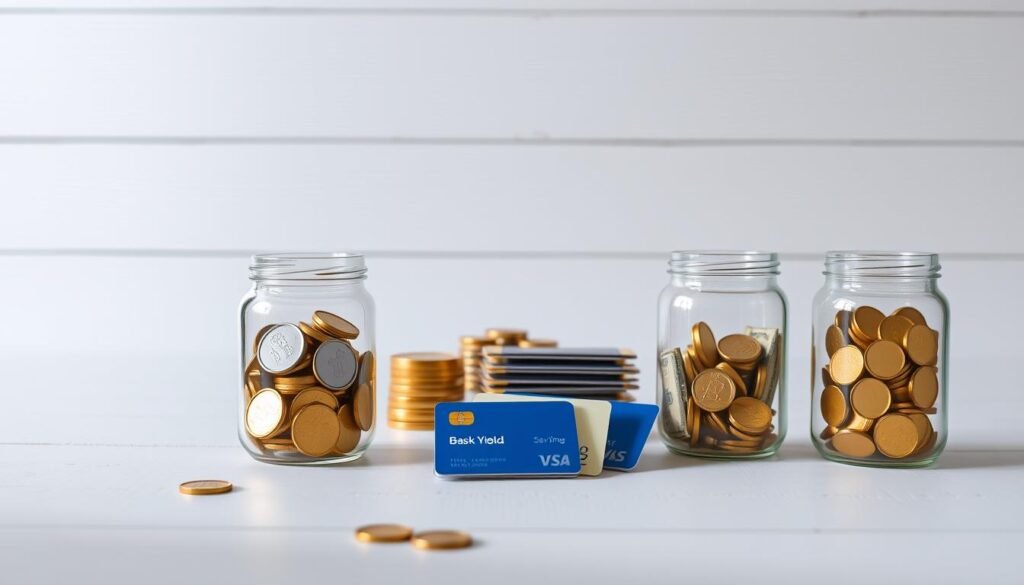
Best high yield savings account USA 2026: Top Picks for You

Curious which options will actually help your cash grow when rates start falling? This roundup gives you clear choices and quick steps so you can open an account in minutes and start earning more.
You'll find a practical look at several leading options, including Axos ONE, SoFi Checking & Savings, UFB Portfolio Savings, and Western Alliance via Raisin.
We explain where current APYs sit, what moves the market, and simple ways to keep your savings working harder. Expect concise details on minimums, perks, and how a recent Fed cut could push rates lower into next year.
By the end of this piece, you’ll know which savings account fits your goals and how to protect FDIC coverage while squeezing the most interest from your cash. Ready to compare top accounts and pick one that matches your routine?
- Why high-yield savings still matter in 2026
- Editor’s quick picks: Best high-yield savings accounts to open now
- How we chose the best high-yield savings accounts
- best high yield savings account USA 2026: Full roundup and who each is best for
- Rate snapshot and outlook for 2026
- Comparison table: APY, minimums, fees, and key perks
- Choose the right account for your goals
- How to maximize your APY in a falling-rate environment
- HYSA vs money market vs CD vs checking
- Safety first: FDIC/NCUA insurance and limits
- Open your account in minutes: Eligibility and steps
- Bonuses, terms, and the fine print to watch
- Visual guide to the best high yield savings account USA 2026
- Internal links to keep learning on StudyFinance
- Authoritative references for rates and policy trends
- Your next move: Open a top HYSA and put your cash to work
Why high-yield savings still matter in 2026
You might see APYs slip in 2026, but that doesn’t mean your emergency fund should sit at big-bank returns. The Federal Reserve trimmed the federal funds rate to 4.00%–4.25% on Sept. 17, 2025, and history shows short-term rates tend to follow that benchmark.
What the late‑2025 Fed rate cuts mean for 2026 APYs
Expect overall rates to drift lower from 2025 peaks, yet online banks often keep offers well above the national trend.
- National average for savings accounts is about 0.40%, while top options paid roughly 4.0%–4.5% in late 2025.
- The federal funds rate anchors short-term interest moves, so cuts can nudge APYs down over time.
- Choose a low-fee, flexible account so you can move funds if competitors change their rates.
National average vs top high-yield savings accounts
Even with cuts, these accounts often deliver multiple times the national average. Watch posted APYs, check conditions, and use automatic transfers so your savings keep growing even if apys drift lower.

Editor’s quick picks: Best high-yield savings accounts to open now
Below are editor-selected options that balance strong APYs with low friction and clear requirements.

Top APY pick: Axos ONE® Savings
Up to 4.46% APY when you meet activity and a $1,500 minimum balance. Good if you keep a steady balance and want a top posted APY.
Best combo checking and savings: SoFi Checking & Savings
Up to 4.50% APY boost (limited time) with eligible direct deposit through 1/31/2026. No monthly fees and $0 to open. Also offers up to $300 bonus for qualifying deposits.
Strong mobile and ATM access: UFB Portfolio Savings
About 3.90% APY across balances, optional ATM card, and a well-rated mobile app for easy transfers and cash access.
Low-friction, widely available: Western Alliance via Raisin
Roughly 4.20% APY with very low minimums on the Raisin marketplace. Good choice if you want to open account with minimal upfront cash.
- No monthly fees on these picks confirm current rates before you apply.
- Before you open account, check compounding, transfer speed, and specific requirements so your balance earns the posted APY.
- Link an external bank and set recurring transfers so your savings grow automatically.
How we chose the best high-yield savings accounts
To build these rankings, we combined published rates, platform usability, and real-world requirements into one process. You get a clear view of which savings accounts actually pay and what hoops you must clear to earn posted apy.

Data sources and editorial independence
We rely on primary disclosures from banks and credit unions, official rate pages, and major aggregator roundups as of late 2025. Our team verifies specifics directly with institutions when possible.
Ranking criteria
We weigh factors you can confirm:
- APY level and stability, plus how easy it is to earn that rate.
- Monthly fees, minimum deposit and minimum balance requirements.
- Compounding frequency, app ratings, customer service access, and access features like ATMs and transfers.
- Limited-time bonuses are noted but do not override long-term value or safety.
- All listed accounts come from FDIC- or NCUA-insured banks or partner programs.
| Criteria | Weight | Why it matters | What you should check |
|---|---|---|---|
| APY & stability | 35% | Drives your interest earnings | Posted rate, recent history |
| Fees & minimums | 25% | Can erode returns quickly | Monthly fees, minimum balance, minimum deposit |
| Usability & access | 20% | Daily banking matters | App scores, ATM access, transfer limits |
| Compounding & bonuses | 20% | Boosts earned interest over time | Daily vs monthly compounding, bonus terms |
best high yield savings account USA 2026: Full roundup and who each is best for
This section pairs leading products with user needs so you can pick the right fit fast.
Axos ONE® Savings
Up to 4.46% apy when you keep a $1,500 minimum balance and meet activity rules. Choose this account if you can hold that balance and want top posted apy without complex steps.
SoFi Checking & Savings
Limited-time boost to 4.50% apy with eligible direct deposits if opened by 1/31/2026, plus up to $300 bonus and no monthly fees. Great when you want a combined checking savings account and simple bonuses.
Openbank High Yield Savings (Santander)
4.20% apy with a $500 minimum deposit to open. Use this if you want a straightforward standalone option from an established bank; note FDIC limits combine with Santander.
Barclays Online Savings
About 3.90% apy and $0 minimum balance. Pick this account for a clean, low-friction setup with no opening requirement.
Discover Online Savings
3.50% apy plus a $150/$200 welcome bonus for qualifying deposits by 03/12/2026. Good if you want brand reliability and a short-term incentive.
Synchrony High Yield Savings
Roughly 3.80% apy and an optional ATM card with up to $5 in ATM fee reimbursements per cycle. Ideal if you need occasional cash access.
UFB Portfolio Savings
About 3.90% apy with a well-rated mobile app. Choose this account if you manage funds mainly on your phone and value app features.
Western Alliance via Raisin
Approximately 4.20% apy with low entry and no monthly fees through the Raisin marketplace. Best for easy digital onboarding and competitive returns on modest deposits.
| Product | Representative APY | Open/Min | Standout feature |
|---|---|---|---|
| Axos ONE® Savings | Up to 4.46% | $1,500 min balance | Top posted apy with activity rules |
| SoFi Checking & Savings | Up to 4.50% (promo) | $0 to open | Checking + savings combo, bonus |
| Openbank (Santander) | 4.20% | $500 min to open | Standalone option; FDIC combined with Santander |
| Barclays Online Savings | ~3.90% | $0 min | No-minimum, low friction |
| Discover / Synchrony / UFB / Raisin | 3.50%–4.20% | Varies | Bonuses, ATM options, mobile apps, marketplace access |
Rate snapshot and outlook for 2026
Top posted APYs clustered near 4%–4.5% as of late 2025, so you still earn well above the national norm even after the Fed’s September cut.
Why that matters: the federal funds decision on Sept. 17, 2025 set the funds rate target at 4.00%–4.25%. Banks price deposits around that benchmark, so savings account rates tend to follow policy moves.
How policy flows into your returns
When the Fed trims the interest rate, banks see a lower cost of funds and may trim posted rates. Expect gradual adjustments over weeks, not instant swings.
"Banks often change APYs weeks after a policy move, so check your rate monthly and compare with competitors."
- As of late 2025, many leading APYs sit around 4%–4.5%.
- Because rates are variable, expect incremental shifts rather than sudden drops.
- If easing continues in 2026, APYs may drift lower—keep fees low and your options mobile.
Practical takeaways: split emergency funds between a liquid account and short-term CDs or a money market to hedge rate moves. Use automatic transfers so your balance grows even if the nominal rate softens.
Comparison table: APY, minimums, fees, and key perks
The table below lays out current APY, opening requirements, monthly fees, and standout perks so you can compare at a glance.
| Product | APY | Min to open / Min to earn | Fees & key perks |
|---|---|---|---|
| Axos ONE® Savings | Up to 4.46% | $0 open / $1,500 to earn | $0 monthly fee; activity rules |
| SoFi Checking & Savings | Up to 4.50% (boost) | $0 open / $0 min to earn | $0 fee; promo ends 1/31/2026; checking APY 0.50% |
| UFB Portfolio Savings | ~3.90% | $0 open / $0 min | Optional ATM; reimbursements vary |
| Western Alliance (Raisin) | ~4.20% | Low minimums | $0 monthly fee; marketplace access |
| Discover / Synchrony / Barclays | 3.50%–3.90% | $0 open / $0 min | Bonuses, ATM options, $0 monthly fees |
How to read this
- Compare headline apy with the minimum balance needed to earn it that often determines your real return.
- Watch for monthly fees; even small fees shrink savings if your balance is low.
- Check access features like ATM reimbursements, external transfers, and promo end dates for boosts or bonuses.
"A higher posted rate matters only if you meet the requirements to earn it."
- Reassess rates quarterly and move new contributions when other banks post better account rates.
Choose the right account for your goals
Pick an account that matches your cash flow, not just the highest posted APY. Start by listing how you use your money: do you need one place for bills, or separate places for short-term goals and an emergency fund?
If you want one bank for checking and savings
Go with a bundled product like SoFi. It simplifies transfers, gives budgeting tools, and can deliver an APY boost while the promo runs.
If you prioritize the absolute highest APY
Consider Axos ONE® Savings if you can hold the required balance and meet activity rules. If you maintain the balance, that top rate will pay off.
If you need cash access and ATM reimbursements
Choose UFB Portfolio Savings or Synchrony for optional ATM cards. Synchrony also reimburses up to $5 per statement cycle, which helps when you withdraw cash often.
- Prefer low friction? Use Raisin to open Western Alliance quickly with a low entry and attractive APY.
- Can’t keep a big balance? A no-minimum option may earn more in practice than a higher rate with hurdles.
- Automate transfers, enable round-ups or sub-accounts, and check transfer limits so your money moves when you need it.
"Revisit choices when promos end and confirm current APY on the bank site before you open."
How to maximize your APY in a falling-rate environment
When rates ease, a small set of moves can keep your interest working for you.
Start by claiming any eligible direct deposit boost you can actually maintain. For example, SoFi’s APY boost runs through 1/31/2026 with qualifying deposits, so set a calendar reminder for the promo end date and confirm the deposit rules.
Hit activity and balance requirements consistently. Accounts like Axos require a $1,500 threshold to earn the top APY. If you can meet that balance each month, you lock in the advertised rate rather than a lower tier.
Practical steps to squeeze more yield
- Set recurring transfers the day after payday so your balance earns interest for more days each month.
- Avoid monthly maintenance fees choose accounts with $0 fees so interest isn’t eaten away.
- Track compounding frequency; daily compounding beats monthly on larger balances.
- Don’t chase every promo pick offers whose requirements match your cash flow.
Pairing strategies: short-term CDs and a money market
Ladder a few short-term CDs to lock a slice of your funds at fixed rates while keeping an emergency buffer in a liquid account. When a CD matures, reassess rates and move proceeds back if the HYSA looks comparatively strong.
Consider a money market if you need occasional check or ATM access without moving funds between accounts. It can replace some spending needs while leaving core savings invested to earn the posted APY.
| Strategy | Action | Why it helps |
|---|---|---|
| Direct deposit boost | Enroll and calendar promo end | Instant APY uplift while promo runs |
| Meet balance/activity | Automate transfers to meet thresholds | Secures the top tier rate (e.g., Axos $1,500) |
| CD ladder | Split funds across 3–12 month CDs | Locks yields while keeping staggered liquidity |
| Money market | Use for ATM/check needs | Preserves core savings and adds access |
"Rebalance quarterly: move CD proceeds or extra cash to the highest practical APY while avoiding needless fees."
HYSA vs money market vs CD vs checking
Deciding where to park cash means weighing ease of access against the returns you want. Below is a practical look at how each choice fits everyday use, emergency funds, and when to lean toward a branch or a digital institution.
Liquidity trade-offs and ideal use cases
- HYSA offers a competitive apy and easy transfers. Use it for your emergency savings and short-term goals. APYs are variable, so check rates periodically.
- Money market gives check or debit access for occasional spending. It may have higher minimums or fees, so confirm terms before you move funds.
- CD locks a fixed rate for a set term. It suits money you won’t touch. Early withdrawals usually bring penalties.
- Checking is for daily transactions. It rarely pays meaningful interest, so pair it with a savings account for goals you want to grow.
Using multiple accounts for everyday spending and emergency funds
- Direct deposit into checking, auto-transfer to HYSA for goals.
- Park a portion in a short CD if you can lock rates without needing liquidity.
- Consider a credit union if you value local branches and member service; they often compete on savings and money market offers.
- Keep accounts at different banks or an institution to optimize rates and coverage.
Want a deeper compare? See a concise HYSA vs CD comparison at HYSA vs CD differences to help pick the right mix.
Safety first: FDIC/NCUA insurance and limits
Know where your money lives so federal insurance actually covers it.
What federal insurance protects: FDIC coverage typically protects up to $250,000 per depositor, per institution, per ownership category. For credit unions, the NCUA provides parallel insurance with the same $250,000 per limits.
There are practical differences to watch. "Member FDIC" means your deposit sits directly at a bank with an FDIC charter. When a fintech says "funds insured by FDIC," it usually places your funds at partner banks through a program.
How to stay fully covered
- Treat each legal institution separately deposits at a single institution count toward the $250,000 per limit.
- Dividing money across multiple banks or ownership categories widens coverage.
- Joint accounts often get $250,000 per co-owner at the same institution; use this for couples.
- For credit union holdings, confirm the NCUA certificate and how it treats your accounts.
Watch brand relationships and marketplaces
Some divisions share a charter (for example, Openbank and Santander). That means your balances combine for insurance purposes at the same institution. Marketplaces such as Raisin place funds at multiple partner banks, so confirm which underlying banks hold your funds and how much sits at each.
| Risk area | What to check | Action |
|---|---|---|
| Single institution limits | Insurance certificate or FDIC/NCUA lookup | Split funds to another bank if over $250,000 per |
| Fintech partner programs | Which program banks hold your funds | Verify per-bank balances and documentation |
| Ownership categories | Individual vs joint vs business rules | Structure ownership to add coverage layers |
"Verify insurance by checking the FDIC or NCUA certificate and keep routing details on file."
Recalculate coverage when you open, close, or move sizable sums. That simple step helps your savings remain protected while you chase better APY elsewhere.
Open your account in minutes: Eligibility and steps
Opening a new account is faster than you think most online applications take under ten minutes. Gather a government ID, your Social Security number, and current bank routing and account numbers before you start.
Quick step-by-step
- Choose an institution based on apy, $0 monthly fees, and minimums you can meet.
- Start the online form, verify identity, and agree to the terms.
- Fund the new account via ACH transfer, wire, or mobile check deposit.
- Set recurring transfers or direct deposit to automate savings and any bonus triggers.
Documents and common funding options
Most banks ask for a government ID, Social Security number, and proof of address. Funding usually works by ACH, wire, or a mobile deposit.
What to do if you’re declined (ChexSystems tips)
If you’re declined, request your ChexSystems report and dispute errors. Pay off small unpaid items, then reapply or pick a second‑chance savings account or a credit union that skips ChexSystems.
"Keep PDFs of your new-account terms, posted apy, and funding receipts for easy follow-up."
Bonuses, terms, and the fine print to watch
Before you chase a welcome bonus, read the timelines and thresholds closely so you don’t miss cash you already earned.
Minimum balance, qualifying deposits, and timelines
Track windows precisely. Some promos require qualifying deposit amounts within a set period. For example, Discover offers $150 with $15,000 or $200 with $25,000 in qualifying deposits within 45 days; the bonus pays within 60 days and is taxable.
Meet the minimum balance and deposit rules exactly. Missing the threshold by even a dollar can forfeit the incentive. Log offer codes and keep proof until the bonus posts and the tax year closes.
APY tiers, compounding frequency, and withdrawal limits
Understand that advertised annual percentage yield may require a specific minimum balance or direct deposit. Axos, for instance, needs $1,500 to hit its top tier.
Compounding matters: daily compounding yields more total interest than monthly at the same percentage yield. Also watch withdrawal limits exceeding them can trigger fees or account conversion.
- Check transfer holds and ACH limits so you can meet deposit windows.
- Confirm $0 monthly fees; a fee can erase a welcome bonus’s value.
- Remember: bonuses count as taxable interest—expect 1099‑INT reporting when thresholds apply.
| Item | Why it matters | Action |
|---|---|---|
| Deposit window | Controls bonus eligibility | Automate transfers to meet deadlines |
| APY tier | Determines your effective percentage yield | Maintain required minimum balance |
| Compounding | Affects total interest earned | Prefer daily compounding when possible |
"Document every step screenshots, confirmation emails, and transfer receipts until the bonus posts and taxes are clear."
Visual guide to the best high yield savings account USA 2026
Use these visuals to speed your decision and avoid surprises when you sign up.
Mobile app dashboards
Previewing dashboards helps you judge daily usability. Look for clear balance views, transfer buttons, and promo banners that call out APY boosts.
APY comparison snapshot
This photo condenses rates, minimums, and fees so you can shortlist accounts at a glance. A slightly lower rate with no fees can win in practice.
Signup and funding steps
The step-by-step image shows ID checks, ACH funding, and direct deposit setup to trigger boosts. Save or print it before you apply.
FDIC/NCUA coverage diagram
See how $250,000 limits work and when divisions like Santander/Openbank combine for insurance. That diagram helps you split large balances safely.
| Photo | Focus | Key detail | What to check |
|---|---|---|---|
| Mobile dashboards | App clarity | Promos, transfers, ATM access | Ease of navigation |
| APY table | Rates & fees | 4%–4.5% ranges highlighted | Minimums and monthly fees |
| Signup steps | Funding flow | ID, ACH, direct deposit | Promo windows and thresholds |
| Insurance diagram | Coverage | $250,000 per institution | Underlying bank charters |
Internal links to keep learning on StudyFinance
Want to dig deeper? Use these StudyFinance guides to take practical next steps and keep your savings strategy aligned with changing rates.
Explore updated picks and tactics:
- Explore high-yield savings strategies and updated picks to keep your earnings competitive and compare current offers.
- Compare top checking options if you want one login for spending and saving; pair your checking with a strong savings option for easy transfers.
- Learn when to lock rates with CDs or use a money market for access and stability while rates shift.
- Build or right-size your emergency fund with step-by-step guidance so your money is where you need it most.
Bookmark these pages and check them quarterly as rates evolve. Use internal comparisons to confirm minimums, fees, and any new introductory offers before you apply.
Cross-reference checking and savings pages to streamline transfers and automate your plan. If you consolidate banks, start with checking, then add the savings product that fits your goals.
| Topic | What you’ll learn | Action to take |
|---|---|---|
| High-yield strategies | Updated picks, qualifying rules | Review rates and automate transfers |
| Checking options | Fees, linked transfers, promos | Pick one login and enable direct deposit |
| CDs & money markets | When to lock vs keep access | Build a ladder or use money market for ATM needs |
| Emergency fund | Target balance, timeline, allocation | Set a weekly or monthly transfer goal |
Use primary sources to verify rates and insurance details before moving meaningful funds.
Check these official pages first. They explain why posted account rates change and how insurance applies to your deposits at each institution.
Federal Reserve statements on policy
Review Fed press releases and meeting notes to see where the federal funds rate stands and when policy may shift. Use the Fed’s calendar to plan timing for moves.
FDIC resources on deposit insurance
Confirm the $250,000 limits and ownership rules for every institution holding your funds. That helps you avoid surprise coverage gaps.
Aggregators and rate roundups
Cross-check current account rates and APYs with reputable aggregators and always verify the bank’s own disclosures before you act.
"Rates can change quickly double-check the source and save the terms when you open an account."
| Reference | What to check | Why it helps |
|---|---|---|
| Federal Reserve | Policy statements, meeting dates | Anticipate federal funds moves and market timing |
| FDIC | Coverage rules per institution | Protect deposits across multiple institutions |
| Aggregators / bank disclosures | Posted account rates, promo terms | Validate APYs and timing before you transfer funds |
- Compare multiple sources; small timing differences can matter.
- Save promo pages and set a quarterly reminder to recheck rates.
Your next move: Open a top HYSA and put your cash to work
Make your next move: open a top HYSA and put your cash to work.
Pick the fit that matches your routine Axos ONE® Savings (up to 4.46% APY), SoFi (up to 4.50% APY boost through 1/31/2026 with direct deposit), UFB (~3.90% with ATM access), or Western Alliance via Raisin (~4.20% with low entry).
Open an account online in minutes: verify identity, link funding, and schedule recurring transfers so your balance grows automatically. Set a calendar reminder for any promo end dates and document the posted APY and terms at signup.
Watch rates and move new deposits if peers pay more. Use our internal guides on picks, checking, CDs, and emergency funds. Stay within FDIC/NCUA limits by spreading funds across banks or ownership categories. Don’t wait start earning better interest today.
If you want to know other articles similar to Best high yield savings account USA 2026: Top Picks for You you can visit the category Finance.






Leave a Reply